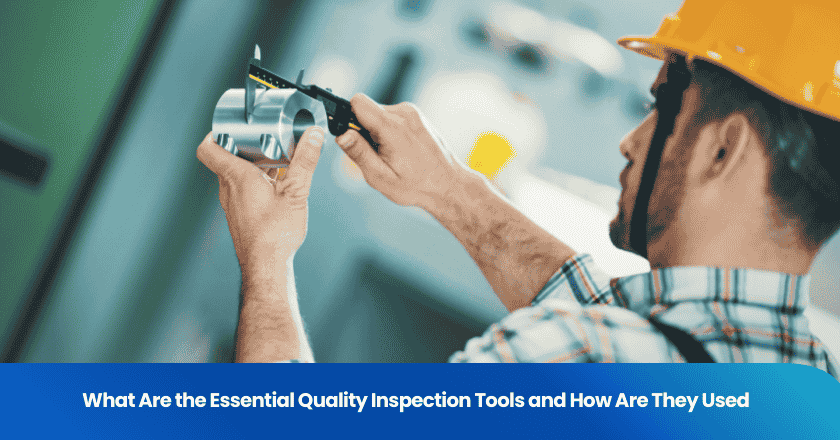
You rely on quality inspection tools such as calipers, micrometers, check sheets, control charts, microscopes, and digital scanners to maintain high standards. Quality inspection ensures consistent product performance and strengthens customer trust. You apply inspection techniques to detect defects, measure dimensions, and verify compliance. Inspection techniques help you assess quality at every stage. Quality management depends on precise inspection, effective inspection techniques, and thorough documentation. Quality inspection techniques allow you to evaluate, record, and improve processes. You gain confidence in your products through careful inspection and robust quality management.
Using the right inspection techniques and quality management approach leads to reliable results and satisfied customers.
Key Takeaways
- Quality inspection uses tools like calipers, microscopes, and digital scanners to check products and keep standards high.
- Inspection helps find defects early, ensures products meet rules, and keeps customers happy.
- Different tools serve different needs: measurement tools check size, visual tools spot surface issues, and digital tools gather precise data.
- Statistical and quality management tools analyze inspection results to improve processes and prevent problems.
- Choosing the right tools and following clear inspection steps leads to better quality, less waste, and ongoing improvement.
Quality Inspection Overview
Definition
You use quality inspection to evaluate products, components, or processes. This step helps you confirm that everything meets specific standards. Inspection techniques guide you in checking measurements, appearance, and function. You apply inspection at different stages of production. The quality inspection process includes planning, executing, and recording results. You rely on common inspection techniques such as visual checks, measurements, and digital analysis. These inspection techniques help you identify defects and prevent faulty products from reaching customers. You use inspection to support quality management and quality assurance goals. Inspections provide you with data to improve your processes and maintain high quality.
Importance
You cannot overlook the importance of quality inspection in your operations. Inspection techniques protect your reputation and ensure customer satisfaction. You use inspection to reduce waste and avoid costly recalls. The importance of inspection techniques becomes clear when you see how they prevent errors and maintain consistency. You depend on inspections to verify compliance with regulations and standards. Quality inspection supports your quality management system by providing reliable data. You use inspection techniques to monitor trends and spot issues early. Inspections help you achieve quality assurance by confirming that products meet requirements. You improve your processes by analyzing inspection results. Quality inspection and quality management work together to deliver safe, reliable products.
Tip: Regular inspections and effective inspection techniques help you maintain control over your quality inspection process and drive continuous improvement.
Essential Quality Inspection Tools
Measurement Tools
You rely on measurement tools to check the physical dimensions of products and components. These tools help you confirm that each item meets the required specifications. You use calipers, micrometers, rulers, and tapes to measure length, width, thickness, and diameter. These inspection tools give you precise readings, which are essential for quality inspection.
- Calipers: You use calipers to measure internal and external dimensions. For example, you can check the diameter of a metal rod before assembly.
- Micrometers: You use micrometers for highly accurate measurements of small objects. You might measure the thickness of a sheet of metal to ensure it matches design requirements.
- Rulers and Tapes: You use rulers and tapes for quick checks of length or width. For instance, you can verify the length of a plastic part during production.
Tip: Always calibrate your measurement tools before use to maintain accuracy in your quality inspection process.
Visual Inspection Tools
You use visual inspection tools to detect surface defects, color inconsistencies, or assembly errors. These tools help you spot issues that might affect product appearance or function. Visual inspection forms a key part of your inspection techniques.
- Microscopes: You use microscopes to examine small parts or fine details. For example, you can inspect electronic circuit boards for soldering defects.
- Magnifiers: You use magnifiers to enhance your view of product surfaces. You might check for scratches or cracks on glass components.
- Arrow Stickers: You use arrow stickers to mark defects during inspection. This helps you communicate issues to your team for corrective action.
- Cameras: You use cameras to document defects or record inspection results. This supports your quality management system by providing visual evidence.
You can also use automated visual inspection systems to speed up the process and reduce human error. These systems use cameras and software to identify defects quickly.
Digital Inspection Tools
You use digital inspection tools to collect precise data and automate parts of your quality inspection process. These tools help you improve efficiency and reduce manual errors. Digital inspection tools play a vital role in modern quality management.
- Coordinate Measuring Machines (CMMs): You use CMMs to measure complex shapes and geometries. For example, you can verify the dimensions of a machined part with high accuracy.
- 3D Scanners: You use 3D scanners to create digital models of products. This allows you to compare the scanned data with design files and detect deviations.
- Power Testers: You use power testers to check the electrical performance of products. For instance, you can test the output of a power supply unit during inspection.
Note: Digital inspection tools often connect to your quality management system, making it easier to track and analyze inspection data.
Statistical Tools
You use statistical tools to analyze inspection data and monitor trends in your production process. These tools help you identify patterns, root causes, and areas for improvement. Statistical tools form the backbone of your quality management efforts.
Here are the seven quality control (7QC) tools you should know:
| Tool | Description | Practical Example |
|---|---|---|
| Check Sheet | Data collection form for tracking defects | You record the number of defects found per shift |
| Control Chart | Graph showing process stability over time | You monitor product weight to detect variations |
| Histogram | Bar graph showing frequency distribution | You analyze the spread of part measurements |
| Pareto Chart | Bar graph highlighting the most common issues | You identify the top causes of product failures |
| Stratification | Separates data to find patterns | You group defects by machine or operator |
| Scatter Diagram | Plots relationship between two variables | You check if temperature affects defect rates |
| Flow Chart | Diagram showing process steps | You map the inspection process for training |
| Fishbone Diagram | Identifies root causes of problems | You analyze why a defect keeps recurring |
You use these tools to support your inspection techniques and drive continuous improvement in your quality management system.
Quality Management Tools
You depend on quality management tools to organize, monitor, and improve your inspection process. These tools help you maintain high standards and achieve your quality goals. Quality management tools support your inspection techniques and ensure consistent results.
- Quality Management Systems (QMS): You use a QMS to document procedures, track inspection results, and manage corrective actions. This system helps you standardize your inspection process and comply with regulations.
- Statistical Process Control (SPC): You use SPC to monitor production processes in real time. For example, you can track key measurements and respond quickly to deviations.
- Sampling Plans: You use sampling plans to decide how many items to inspect from a batch. This approach saves time while maintaining confidence in product quality.
- Audit Checklists: You use audit checklists to verify compliance with internal and external standards. This ensures your inspection techniques align with your quality management objectives.
Remember: Quality management tools help you collect data, analyze trends, and make informed decisions. You improve your inspection process and reduce defects by using these tools effectively.
You strengthen your quality assurance efforts by combining measurement, visual, digital, statistical, and quality management tools. You create a robust inspection system that supports your quality control and continuous improvement initiatives.
Quality Inspection in Practice
Tool Selection
You choose inspection tools based on your inspection techniques and the specific requirements of your process. You start by reviewing your inspection checklist and identifying the critical quality attributes for each product. You select measurement tools when you need to verify dimensions. You use visual inspection tools to detect surface defects. You rely on digital inspection tools for complex geometries or automated data collection. You consider the type of inspection, the stage of production, and the level of accuracy required. You match your inspection techniques to the product and process. You use your inspection checklist to confirm that you have the right tools for each inspection step. You integrate quality management principles to ensure consistency and reliability.
Tip: You improve efficiency by standardizing your inspection checklist and training your team on proper inspection techniques.
Application Scenarios
You apply inspection techniques in various industries. In manufacturing, you use calipers and micrometers to check part dimensions. You follow your inspection checklist to inspect each batch and record results in your quality management system. You use visual inspection tools to spot defects on assembly lines. You rely on digital inspection tools for product quality control in high-precision environments. In service industries, you use inspection techniques to verify cleanliness and safety. You document findings using your inspection checklist and report issues through your quality management system. In 3D printing, you use digital scanners to compare printed parts to design files. You analyze inspection data using statistical process control to maintain quality. You integrate inspection results with your quality management system to track trends and implement corrective actions. You use inspection techniques to support product quality control and continuous improvement.
| Industry | Inspection Techniques Used | Quality Management Integration |
|---|---|---|
| Manufacturing | Measurement, visual, digital | QMS, SPC, inspection checklist |
| Service | Visual, checklist-based | QMS, inspection checklist |
| 3D Printing | Digital, measurement, statistical | QMS, SPC, inspection checklist |
You strengthen product quality control by combining inspection techniques with quality management systems and statistical process control.
Quality Management Tools for Continuous Improvement
Process Monitoring
You use quality management tools to monitor your processes and maintain high standards. These tools help you track inspection results and identify trends in your production line. Quality management depends on real-time data from your inspection activities. You apply quality control methods such as Statistical Process Control (SPC) to detect variations early. You can set up control charts to visualize process stability. Quality management tools give you the power to respond quickly when you see a problem. You rely on inspection data to make decisions that protect product quality. You use sampling plans to check batches without inspecting every item. This approach saves time and supports your quality control efforts. You improve efficiency by focusing on areas that need attention.
Effective process monitoring with quality management tools helps you prevent defects and maintain consistency.
Data Analysis
You analyze inspection data using quality management tools to drive continuous improvement. These tools help you understand the root causes of defects and optimize your processes. You use quality control methods like histograms and Pareto charts to visualize data. You can spot patterns that affect quality and take corrective action. Quality management tools support your inspection process by providing clear reports and actionable insights. You use data analysis to measure the impact of changes in your process. Quality management relies on accurate data to guide your decisions. You apply quality control methods to reduce waste and improve product reliability. You use inspection results to set new quality goals and track progress. Quality management tools help you maintain a cycle of improvement.
| Quality Management Tool | Purpose | Example Use Case |
|---|---|---|
| SPC | Process monitoring | Detecting shifts in production |
| Sampling Plans | Efficient inspection | Checking random product samples |
| Pareto Chart | Data analysis | Identifying top defect causes |
You achieve better quality and stronger quality control by using data-driven quality management tools.
You gain the benefits of quality management tools when you use the right inspection tools for every inspection. Inspection supports your quality goals and helps you deliver reliable products. You select inspection tools based on your inspection needs. Inspection ensures you meet quality standards and customer expectations. You use inspection to track quality trends and prevent defects. Inspection data guides your quality improvements. You rely on inspection for process control and quality assurance. Inspection helps you maintain quality at every stage. You stay ahead by updating your inspection methods. You achieve long-term success through proactive inspection and quality management.
FAQ
What is the main purpose of inspection in quality management?
You use inspection to confirm that products meet your quality standards. Inspection helps you identify defects early. You rely on inspection to maintain consistency and protect your reputation. Inspection supports your quality goals and ensures customer satisfaction.
How do you choose the right inspection tool for your process?
You review your inspection requirements and select tools that match your quality needs. You consider the type of inspection, the product’s features, and the level of accuracy required. You use the inspection checklist to guide your selection.
Can inspection improve efficiency in your production line?
You improve efficiency by using inspection to catch problems early. Inspection allows you to address issues before they affect quality. You save time and resources by integrating inspection into your workflow. Inspection data helps you streamline your process.
What are the benefits of using statistical tools in inspection?
You use statistical tools to analyze inspection data and monitor quality trends. These tools help you spot patterns and make informed decisions. You rely on inspection results to drive continuous improvement and maintain high quality standards.
How does inspection support continuous quality improvement?
You use inspection to collect data and track quality over time. Inspection results highlight areas for improvement. You adjust your processes based on inspection findings. Inspection ensures you meet your quality goals and deliver reliable products.
Grow your business with TradeAider Service
Click the button below to directly enter the TradeAider Service System. The simple steps from booking and payment to receiving reports are easy to operate.



